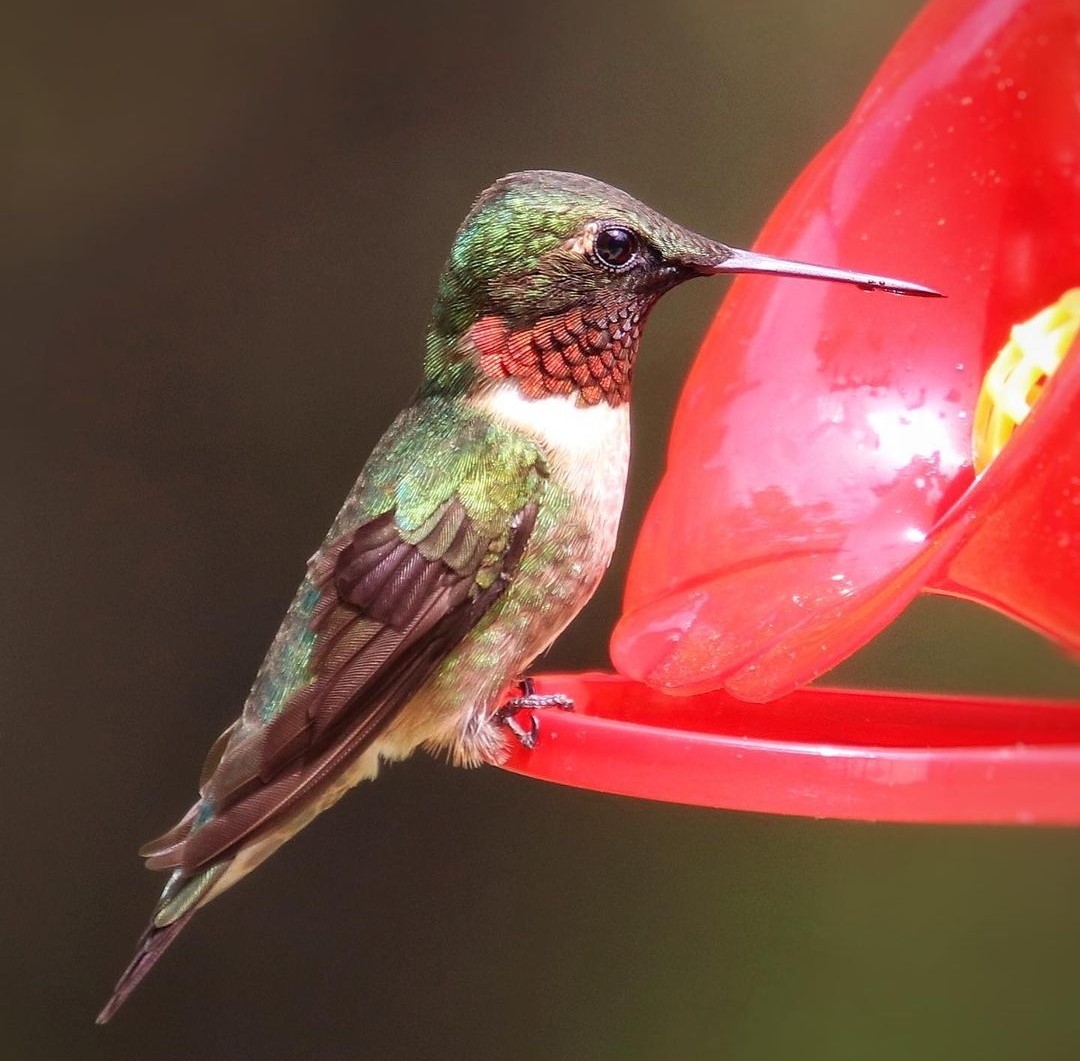This post contains affiliate links.
What types of hummingbirds are found in New Hampshire?
- There are 3 hummingbird species found in New Hampshire.
- Ruby-Throated
- Rufous
- Calliope
New Hampshire is home to hummingbirds that are both year-round and seasonal. There is even one hummingbird species found in New Hampshire that is considered an exotic rare visitor.
While it is easy to assume all hummingbirds are the same when we see them only as a jewel-toned flash of color as they jet around our hanging flowers and porches; they have different temperaments, varied nesting habits, diverse coloring and reside in multiple geographical ranges.
There are 3 categories of hummingbirds found in New Hampshire. Year-round natives, seasonal, and rare hummingbirds.
Hummingbirds are known to exist within certain established ranges, either as year-round natives or as part of a migratory cycle.
While there are species of hummingbirds that are year-round natives to New Hampshire as well as seasonal visitors, there are hummingbirds rarely found in New Hampshire that show up at feeders far outside their established range. These hummingbirds are known in ornithological circles as “vagrants.”
Categories of Hummingbirds:
Year-Round/Native Hummingbirds:
These hummingbirds live in New Hampshire year-round.
- Ruby-Throated (Year-Round Native)
Seasonal Hummingbirds:
These hummingbirds are in New Hampshire temporarily as part of their migratory pattern.
- Ruby-Throated (Seasonal – Some Migrate)
- Rufous (Seasonal – Migrate)
Rare/Vagrant Hummingbirds:
These hummingbirds are outside of their normal geographic range when found in New Hampshire but are occasionally spotted. Not only do these species of hummingbirds have a wide variety of specific geographic ranges, but they are also known to sometimes interbreed with each other, creating hybrids.
- Calliope (Rare – Vagrant)
Because of human intervention, in the form of feeding stations and the transplant of exotic flowers in residential areas, some hummingbirds in mild climates are staying rather than migrating.
Read on to find out more about each of these hummingbird species as well as where and when they can be found in New Hampshire.
Year-Round/Native Hummingbirds
RUBY-THROATED HUMMINGBIRD – (Archilochus colubris)
Conservation Status: Least concerned
Kingdom: Animalia
Phylum: Chordata
Class: Aves
Order: Apodiformes
Family: Trochilidae
Genus: Archilochus
Species: A. colubris
The Ruby-throated hummingbird’s scientific name originated from Carl Linnaeus, a Swedish botanist, who first listed this scientific classification as “Trochilus colubris”. It’s name changed over a hundred years later and was reclassified by Ludwig Reichenbach, a German botanist to “Archilochus colubris”, which is its current scientific name, meaning “top thief” or “sky spirit/sun-god bird”.
Ruby-throated hummingbirds are year-round natives to New Hampshire. While most Ruby-throated hummingbirds are seen year-round, some Ruby-throated hummingbirds prefer to migrate south to winter in Mexico.
Male Ruby-throated hummingbirds have a striking iridescent blood-red gorget, stopping at the neckline. He is identified with a dull metallic green topside, a light gray underbelly and black wings. The Ruby-throated hummingbird is a smaller species of hummingbirds weighing less than 4.5 grams or 2 U.S. dimes and is 2.8 to 3.3 inches in length. The oldest male Ruby-throated hummingbird has been recorded at 5 years.
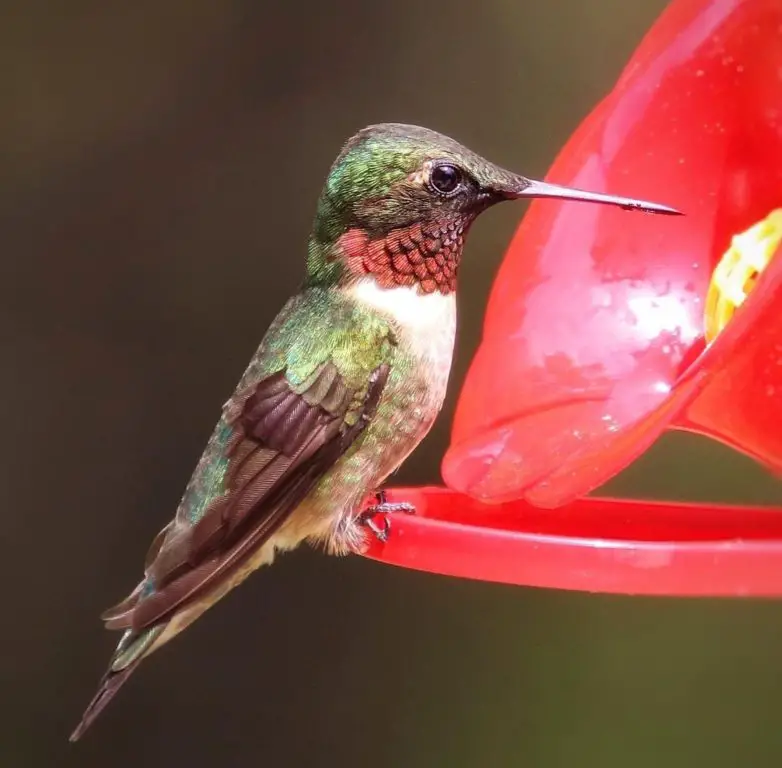
Photo by: paulapaintsart

Photo by: paulapaintsart

Photo by: paulapaintsart
Female Ruby-throated hummingbirds have a white throat with some light stippling and are typically larger than the males. The oldest female Ruby-throated hummingbird has been recorded at 9 years, almost double that of the male.
However, the average lifespan of a Ruby-throated hummingbird is approximately 3-5 years.
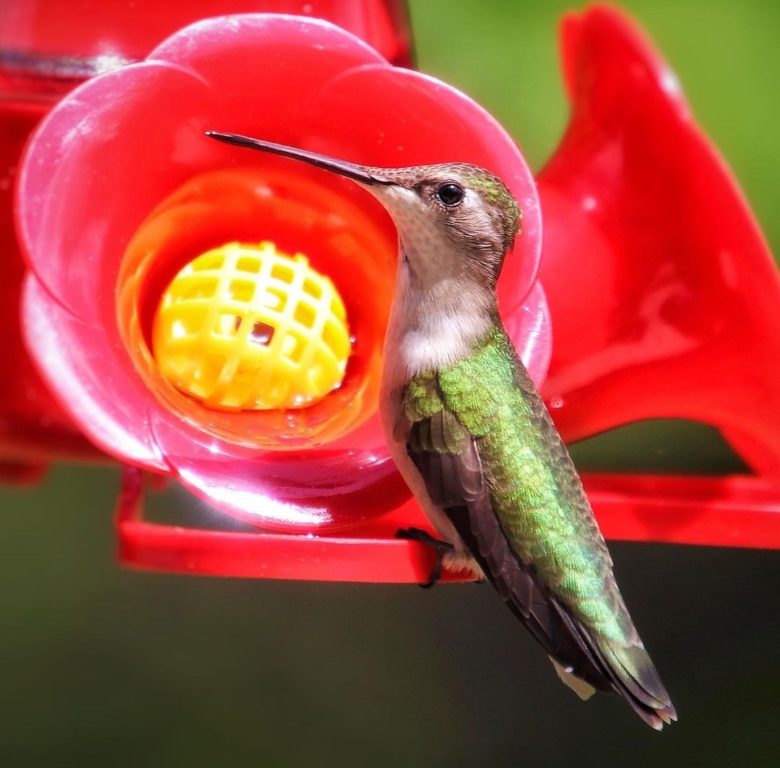
Photo by: paulapaintsart
Juvenile male and female Ruby-throated hummingbirds during their initial stages of life resemble their mother exhibiting a white throat with light stippling.
As the males mature, they begin to display a few specks of color near their neckline and eventually their bolder red throat feathers become more dominant and stately displaying a colorful gorget.
Juvenile females show a light faint grey stippling on their throat. As both sexes mature their less vivid and lighter colored plumage will begin to mature and become darker in color.
Note in both pictures below the newly white fluffy down feathers on this baby/juvenile Ruby-throated Hummingbird’s bottom. Also notice the nice fat reserves they accumulated by being fed by their diligent mother which will sustain it through adolescence.
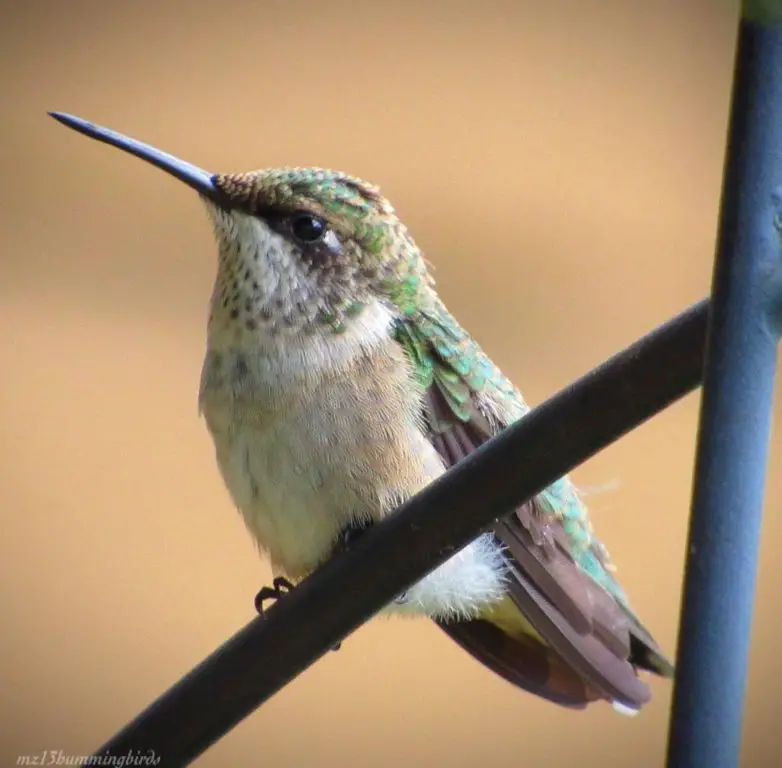
Photo by: mz13hummingbirds
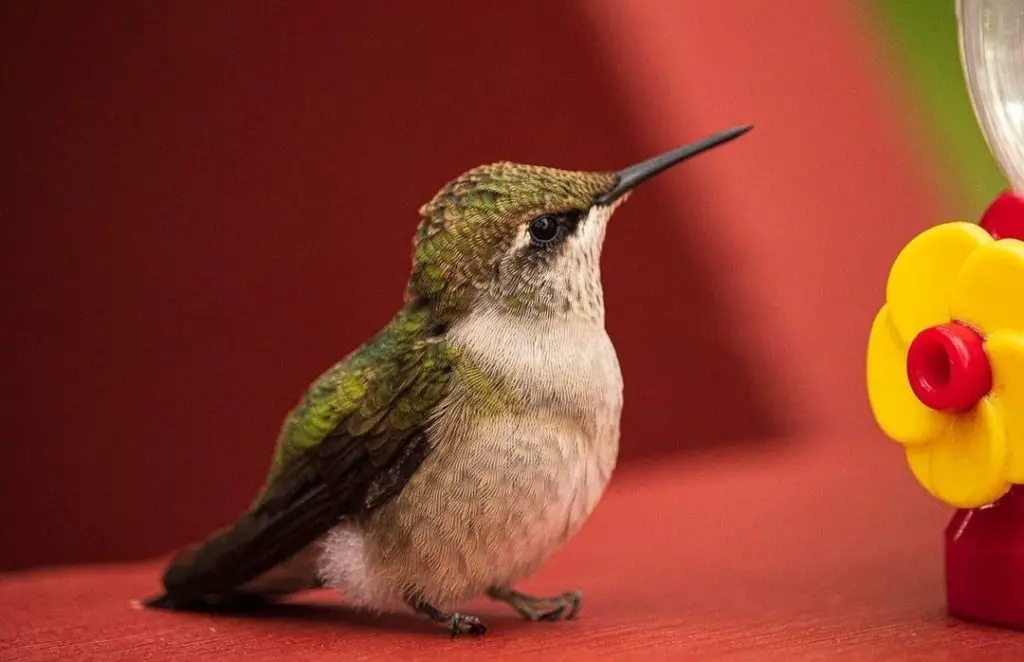
Photo by: MaryLou Ziebarth
Ruby-throated hummingbirds are seen during spring migration as early as the first week of May and some choose to leave New Hampshire as early as September to winter in Mexico during fall migration.
According to The Cornell Lab, the Ruby-Throated hummingbird’s breeding range covers the entire Eastern half of the United States extending from its Southernmost landmass up into Canada.
Ruby-throated hummingbirds are the only species that nest in New Hampshire and the only ones that nest east of the Mississippi River. All other hummingbirds seen in New Hampshire are just passing through to their nesting destination.
There are two migration routes for the Ruby-throated hummingbird during the spring and fall migrations.
The first migration route is a direct but exhausting nonstop journey southwest over the Gulf of Mexico to Mexico and then down to Central America for the winter. The flight distance over the Gulf of Mexico is over 500 miles. Although this is the direct “short” route, there are numerous obstacles faced by these birds.
Some obstacles include not being able to rest, no means to refuel or eat and having to avoid the dangerous tropical Atlantic hurricanes while flying to their destination. To make matters worse, depending on how you look at it, they migrate during the dark hours of the night or are taking the “Red-eye flight”.
Researchers believe their small size makes the energy expenditure of their grueling trans-oceanic migration pattern more taxing for males than for females even though they both double their body’s fat prior to making the migration across the Gulf of Mexico.
The second migration route is over 2,000 miles, flying along the coastline outlining the Gulf of Mexico. Although this is the “long” route, it allows the opportunity to rest and refuel even though there are less food source guarantees along the way.
Scientists are unclear and continue to investigate as to why one group of birds would prefer to take one route over the other.
See my article: Hummingbird Migration in New Hampshire
Ruby-throated hummingbirds prefer open woodland and are often seen in parks, gardens, and backyards as well. They are solitary birds except during mating periods when they are fiercely territorial and aggressive towards hummingbirds of other species.
Even though these hummingbirds have an aggressive side they can still be eaten by predators such as large invertebrates, praying mantises, orb-weaver spiders, and dragonflies.
See pictures of male, female, and juvenile Ruby-throated hummingbirds here…..
Hear sounds of Ruby-throated hummingbirds here…..
Seasonal Hummingbirds
RUFOUS HUMMINGBIRD – (Selasphorus rufus)
Conservation Status: Near threatened
Kingdom: Animalia
Phylum: Chordata
Class: Aves
Order: Apodiformes
Family: Trochilidae
Genus: Selasphorus
Species: S. rufous
The Rufous hummingbirds are seasonal to rare migrants in New Hampshire. Even though they are sometimes seen during spring migration during the first week of May they can also be listed as a rare vagrant to New Hampshire since they are a common resident on the western coast.
The Rufous hummingbird gets its name from the Latin-based word “Red” that is used to describe its reddish-brown coloring.
Male Rufous hummingbirds display an iridescent orange-red gorget, however, in darker lighting it can appear chocolate brown. Their flanks and tail are rusty in color. They have a white to beige underbelly and a black bill. Males can also have green plumage with specks of green color on their rustic-looking backs or on the crown of their head along with chocolate brown dorsal feathers. Their size is 2.8 inches to 3.5 inches in length and weighs 3.2 grams.
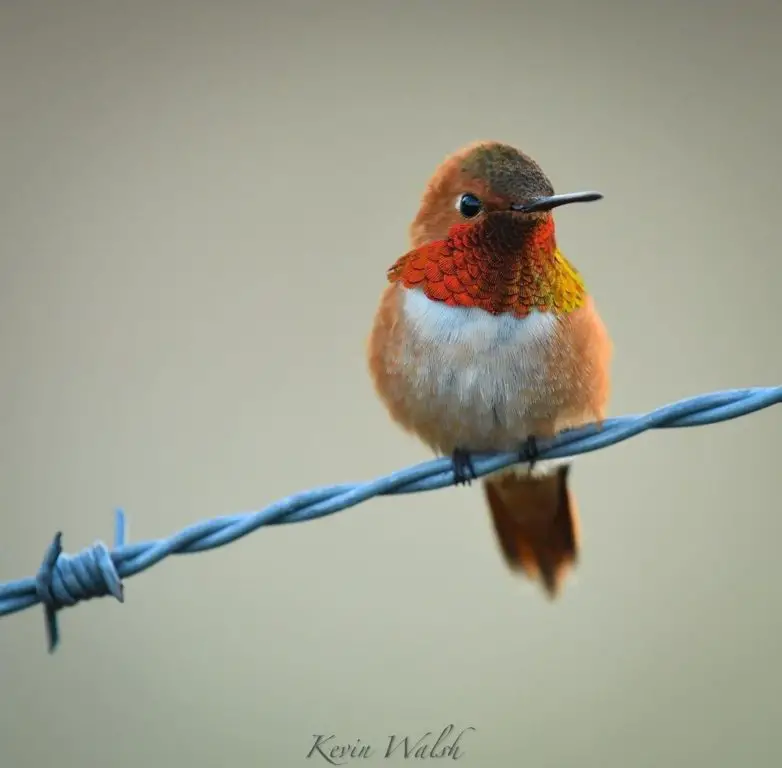
Photo by: Kevin Walsh
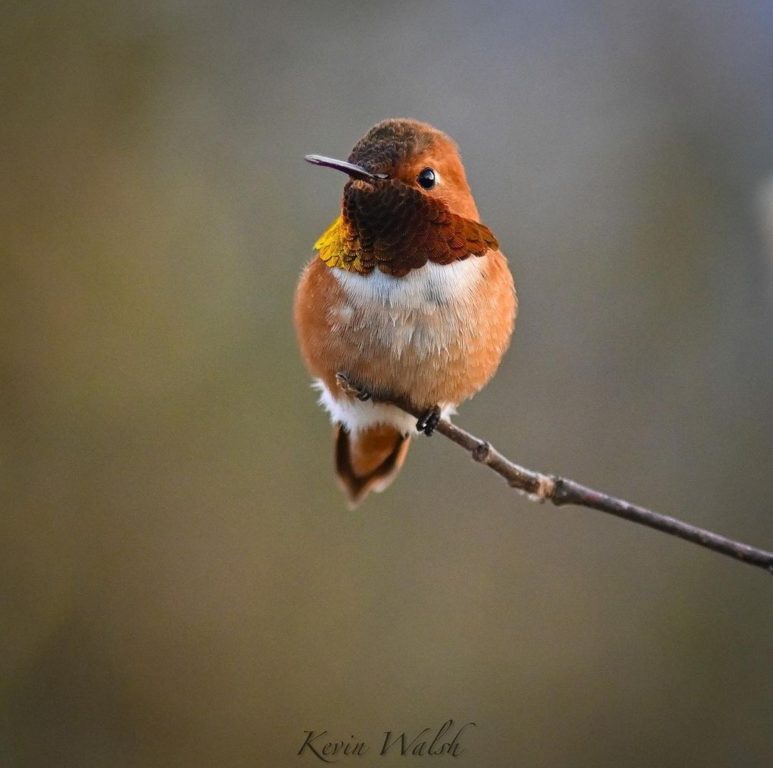
Photo by: Kevin Walsh
Juvenile male Rufous hummingbirds have a rustic look with small iridescent orange specks of color on their throats.
Juvenile Rufous hummingbirds are so similar in coloring and temperament to an Allen’s hummingbird that they are practically indistinguishable in the field. Therefore, identification is established by range rather than appearance.
Female Rufous hummingbirds are green and white with some iridescent orange feathers on their throat. Their tail is dark with white tips and an orange-red base. Female Rufous hummingbirds are slightly larger than the males in anticipation of producing offspring.
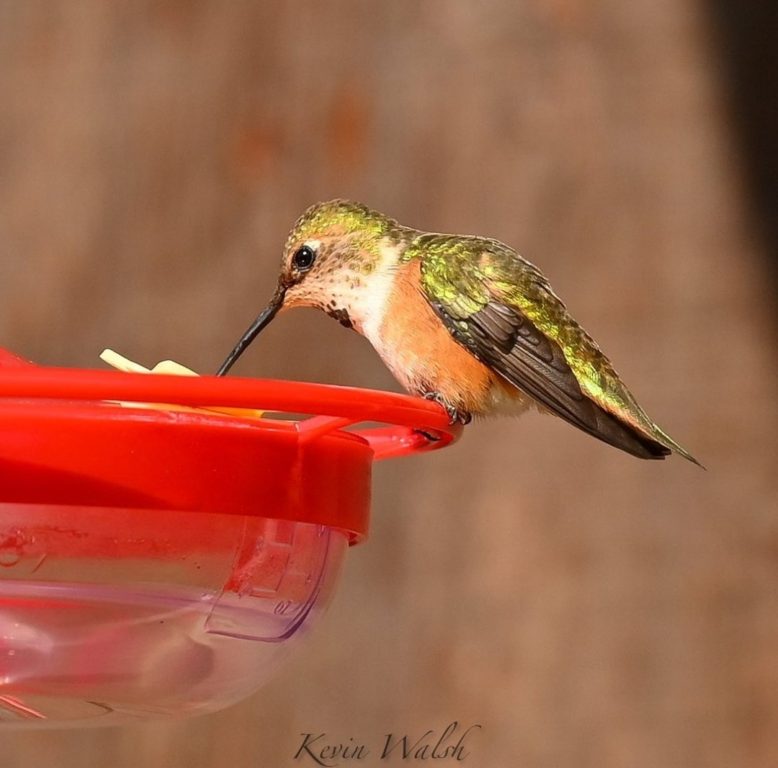
Photo by: Kevin Walsh
Like Allen’s hummingbirds, Rufous hummingbirds are highly territorial and can be aggressive to other hummingbirds and animals. They are fearless and have a reputation to even go as far as to attack squirrels and chipmunks that come too close to their nest. They can outmaneuver all other hummingbirds in the air, making them extremely competitive at feeders.
Rufous hummingbirds make the longest migrations of any other bird in the world, making a clockwise circuit of western America every year that is approximately 3,900 miles. They have one of the northernmost breeding ranges of any hummingbird in the world, nesting as far north as Alaska. Rufous hummingbirds are polygamous and will mate with several partners in a season.
Rufous hummingbirds have excellent memories and have been known to investigate the location of an old hummingbird feeder years after the feeder has been removed.
During a capture and release banding operation in British Columbia, the oldest living recorded female Rufous hummingbird was 8 years and 11 months old.
See my article: 3 Reasons Why Hummingbirds Are Banded
Due to habitat loss in the Pacific Northwest, Rufous hummingbirds are listed at “near threatened” status by the IUCN red list of threatened species.
See pictures of male, female and juvenile Rufous hummingbirds here…..
Hear sounds of Rufous hummingbirds here…..
Rare/Vagrant Hummingbirds
CALLIOPE HUMMINGBIRD – (Selasphorus calliope)
Conservation Status: Least concerned
Kingdom: Animalia
Phylum: Chordata
Class: Aves
Order: Apodiformes
Family: Trochilidae
Genus: Selasphorus
Species: S. calliope
Calliope hummingbirds, a rare visitor to New Hampshire, are named after a Greek mythological muse, who represented poetry and eloquence. Calliope means “beautiful voice” in ancient Greek.
Calliope hummingbirds are the smallest long-distance migratory bird in the world. All tend to breed in the higher elevations of the Rocky Mountains.
Male Calliope hummingbirds are easily identified by their iridescent purple crown and long striking spaced outline row of feathers that project down the sides of their throat. Like many hummingbirds the backs are metallic green and these birds measure 3 inches in length and weigh 2-3 grams.
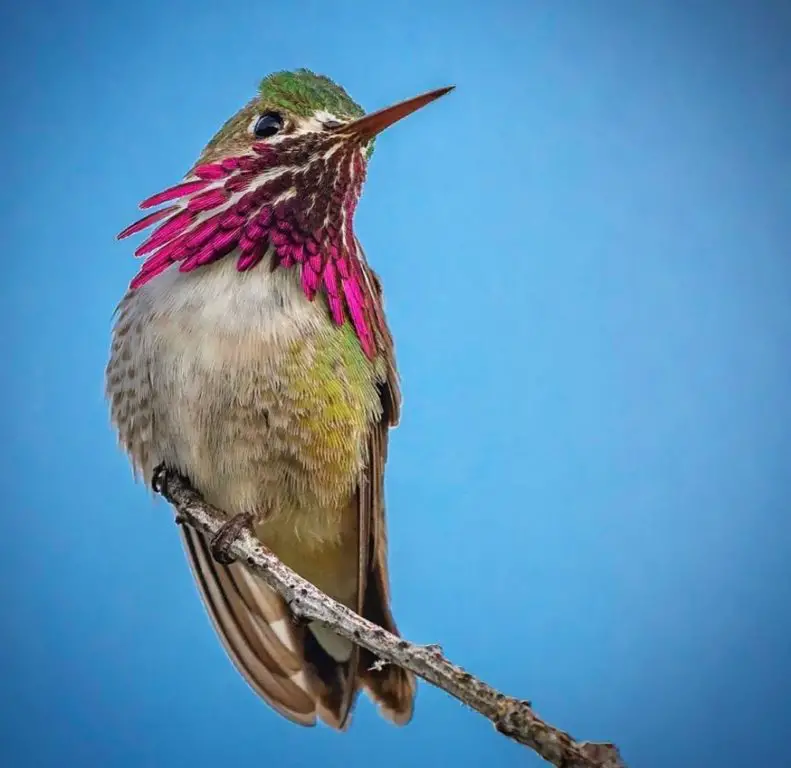
Photo by: sony_alpha_male
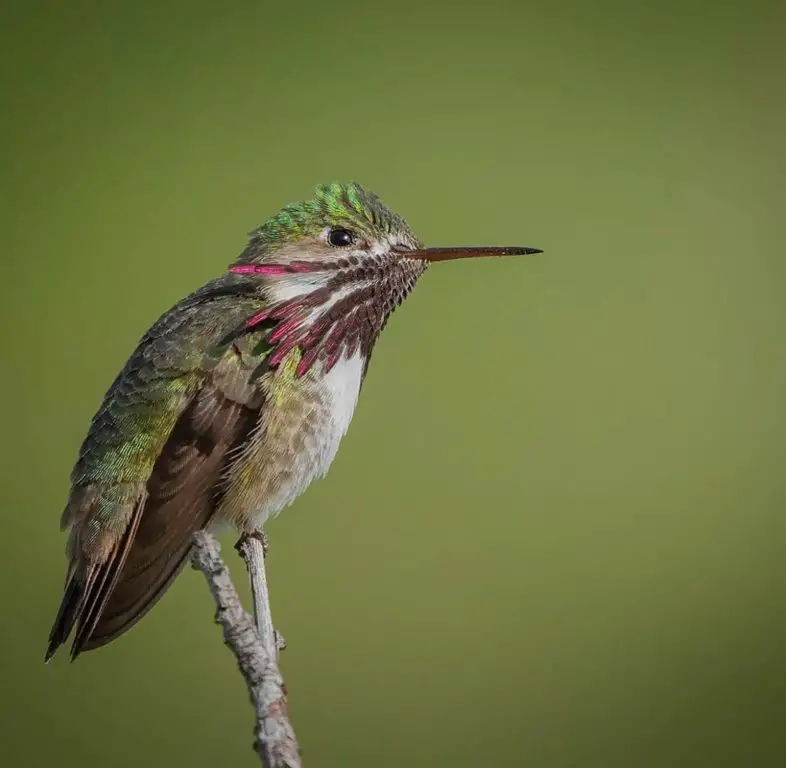
Photo by: sony_alpha_male
Female Calliopes have white underbellies and chins with some dark spotting at the throat. They have gray-green crowns and buff-colored flanks which are the underbelly or wing of a bird. Females sport dark tails with white tips.

Photo by: sony_alpha_male
Like many hummingbirds, Calliopes communicate not just by their song, but also by manipulating their feathers during flight to make different buzzing noises that act as a form of language and communication.
Male Calliope hummingbirds establish a breeding territory and mate with every available female hummingbird that accepts his courtship.
When a female Calliope hummingbird builds a nest, they are known to both nest on the top of pine cones and to steal building materials from the nests of other birds in order to construct their own. They will also dismantle nests from previous seasons and recycle them in their new nest.
Therefore, they are often attacked and chased by larger, more aggressive species of hummingbirds, such as Allen’s and Rufous hummingbirds. This causes them to maintain a relatively low profile in comparison to other species.
Because Calliope hummingbirds have a more restricted wintering range than most hummingbirds, they are particularly vulnerable to habitat loss and natural disasters, such as climate change and wildfires.
During a capture and release banding operation in Idaho, the oldest living recorded female Calliope hummingbird was 8 years and 11 months old when she was captured twice, once in 2007 and again in 2014.
See my article: 3 Reasons Why Hummingbirds Are Banded
View more pictures and sounds of Calliope hummingbirds below.
See pictures of male, female and juvenile Calliope hummingbirds here…..
Hear sounds of Calliope hummingbirds here…..
Happy Hummingbird Watching!

Backyard Visitors participates in affiliate programs which compensate us for referring traffic.

